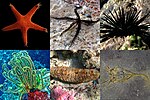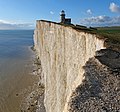Sea urchin (redirect from Echinoidea)
(/ˈɜːrtʃɪnz/) are typically spiny, globular animals, echinoderms in the class Echinoidea. About 950 species live on the seabed, inhabiting all oceans and depth...
80 KB (8,035 words) - 22:22, 30 December 2024
World Register of Marine Species (redirect from World Echinoidea Database)
The World Register of Marine Species (WoRMS) is a taxonomic database that aims to provide an authoritative and comprehensive catalogue and list of names...
9 KB (832 words) - 16:03, 4 December 2024
1900 species), Ophiuroidea (brittle stars, with around 2,300 species), Echinoidea (sea urchins and sand dollars, with some 900 species), Holothuroidea (sea...
110 KB (11,030 words) - 04:09, 4 January 2025
and does not pose a serious threat to humans. As a member of the class Echinoidea, the anatomy of Diadema setosum is that of a typical sea urchin. All of...
14 KB (1,610 words) - 06:08, 6 November 2024
(July/August): 12–13. Dix, Trevor G. (June 1970). "Biology ofevechinus chloroticus(echinoidea: Echinometridae) from different localities". New Zealand Journal of Marine...
17 KB (1,896 words) - 09:24, 7 November 2024
Nusplingen Limestone (section Echinoidea)
The Nusplingen Limestone (German: Nusplingen Plattenkalk) is a geological formation in Baden-Württemberg, Germany. It preserves fossils dating to the Kimmeridgian...
27 KB (1,231 words) - 04:52, 19 November 2024
The Solnhofen Limestone or Solnhofen Plattenkalk is a collective term for multiple Late Jurassic lithographic limestones in southeastern Germany, which...
134 KB (4,077 words) - 05:36, 22 December 2024
The Echinothurioida are an order of sea urchins in the class Echinoidea. Echinothurioids are distinguished from other sea urchins by the combination of...
7 KB (711 words) - 19:09, 26 July 2023
This List of echinoderm orders concerns the various classes and orders into which taxonomists categorize the roughly 7000 extant species as well as the...
10 KB (470 words) - 20:31, 9 December 2024
classification Domain: Eukaryota Kingdom: Animalia Phylum: Echinodermata Class: Echinoidea Superorder: Gnathostomata Order: Clypeasteroida Suborders and families...
15 KB (1,568 words) - 00:02, 3 January 2025
April 2017). "A diverse assemblage of Permian echinoids (Echinodermata, Echinoidea) and implications for character evolution in early crown group echinoids"...
116 KB (11,952 words) - 15:11, 19 December 2024
Long Island Sound is a large marine estuary in the Northeastern United States. It forms the maritime border between the states of New York and Connecticut...
14 KB (1,145 words) - 22:50, 24 October 2024
and exclusively marine, including starfish (Asteroidea), sea urchins, (Echinoidea), brittle stars (Ophiuroidea), sea cucumbers (Holothuroidea) and feather...
45 KB (4,979 words) - 17:17, 31 December 2024
stiff to limp depending on the current for optimal filter feeding. The Echinoidea, sand dollars, use MCTs to grow and replace their rows of teeth when they...
60 KB (6,701 words) - 08:45, 20 December 2024
and feather stars) Asteroidea (star fish) Ophiuroidea (brittle stars) Echinoidea (sea urchins) Holothuroidea (sea cucumbers) Entoprocta Gastrotricha Gnathostomulida...
8 KB (503 words) - 23:52, 29 December 2024
Pitkin Formation (section Echinoidea, Sea Urchins)
The Pitkin Formation, or Pitkin Limestone, is a fossiliferous geologic formation in northern Arkansas that dates to the Chesterian Series of the late Mississippian...
20 KB (1,286 words) - 08:32, 18 November 2024
(2024). "A paedomorphic dwarf species, Gauthieria pumilio sp. nov. (Echinoidea: Phymosomatidae), from the Campanian (Late Cretaceous) of Hannover, Germany"...
390 KB (35,682 words) - 20:14, 4 January 2025
British fossil Echinodermata of the Oolitic formations. Volume I – The Echinoidea. London: The Palaeontographical Society. Wright, Thomas (1863–1880). Monograph...
5 KB (511 words) - 11:12, 27 June 2024
The Camarodonta are an order of globular sea urchins in the class Echinoidea. The fossil record shows that camarodonts have been in existence since the...
3 KB (177 words) - 03:01, 3 December 2023
Brissus gigas (category Echinoidea stubs)
"The Largest Recorded Specimen of the Giant Heart Urchin, Brisus gigas (Echinoidea: Brissidae)". Records of the Auckland Museum. 47: 89–92. ISSN 1174-9202...
2 KB (194 words) - 22:44, 14 April 2024
during compaction. Flint is often deposited around larger fossils such as Echinoidea which may be silicified (i.e. replaced molecule by molecule by flint)...
23 KB (2,605 words) - 00:05, 13 December 2024
The marine waters of the Houtman Abrolhos, an island chain off the coast of Western Australia, has been recorded as containing 172 species of echinoderm...
8 KB (577 words) - 15:23, 18 January 2023
concentrations in the ink sac of the cuttlefish Sepia Officianalis), echinoidea (found in sand dollars, and the hearts of sea urchins), holothuroidea...
32 KB (3,908 words) - 20:24, 18 April 2024
starfish (Asteroidea), sea cucumbers (Holothuroidea), and sea urchins (Echinoidea). Appendage regeneration in echinoderms has been studied since at least...
83 KB (9,307 words) - 17:57, 23 November 2024
Mooi R (eds.). "Heterocentrotus mamillatus (Linnaeus, 1758)". World Echinoidea Database. World Register of Marine Species. Clark, Ailsa M. (1971). Monograph...
11 KB (1,430 words) - 23:22, 17 October 2024
Saima, Mahmoud; Asan, Anhar (2025-03-01). "Selected regular echinoids (Echinoidea) from the upper Campanian–Maastrichtian along the western borders of the...
2 KB (168 words) - 05:46, 12 December 2024
Grasshopper Orthoptera 29.3 20.5 20.7 29.3 1.00 0.99 41.2 58.6 Sea urchin Echinoidea 32.8 17.7 17.3 32.1 1.02 1.02 35.0 64.9 Wheat Triticum 27.3 22.7 22.8...
19 KB (2,014 words) - 23:11, 16 December 2024
Caenopedina diomedeae (category Echinoidea stubs)
(2010). Caenopedina diomedeae (Mortensen, 1939). In: Kroh, A. & Mooi, R. (2010) World Echinoidea Database. at the World Register of Marine Species. v t e...
897 bytes (57 words) - 06:50, 11 July 2021
Scientific classification Kingdom: Animalia Phylum: Echinodermata Class: Echinoidea Order: Echinoida Family: Echinometridae Genus: Colobocentrotus Species:...
3 KB (315 words) - 19:19, 1 October 2024
























